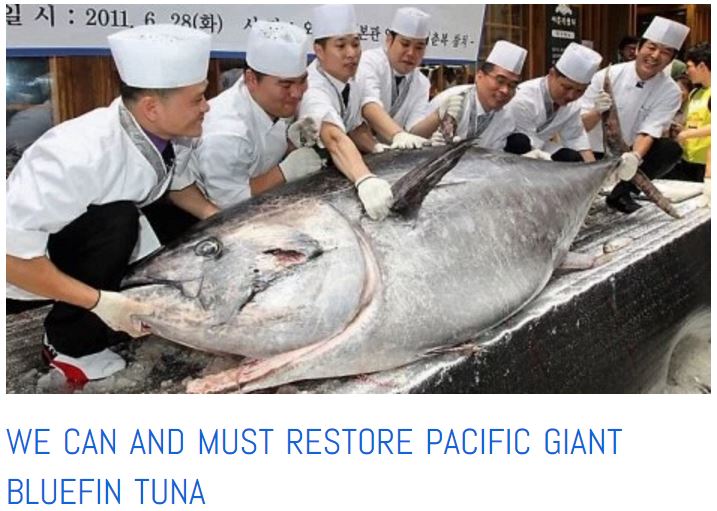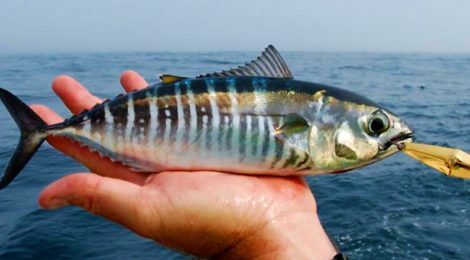
Pacific Tuna Remain In Peril As Tunacrats Fail To Act To Restore Bluefin Pastures
Tunacrats meeting just ended without new tuna agreements, despite 97% of Pacific Bluefin Tuna having been eradicated.
Political will to save the last 3% of the tuna missing as tuna nations argued over who should be first and suffer most to save the last of the fish.
What the tunacrats refused to consider is restoration of Pacific tuna pastures where for fraction of 1% of the value of the catch the Pacific Bluefin and countless other fish could be returned and sustained at historic abundance levels immediately by restoring their ocean fish pastures.
Representatives of 40 Pacific island states and countries around the Pacific Ocean meeting in Japan only argued over who ought to take the first and foremost step to help save Pacific tuna, especially the Giant Bluefin Tuna. Meeting in sumptuous luxury for a week the delegates refused to reach an agreement on bluefin tuna stock protection measures and to adopt capture cutbacks amid concerns over dwindling supplies due to overfishing. (That’s a juvenile Bluefin Tuna at the top of this post.)
The tunacrats focused exclusively on the catch and who had the right to the last of the tuna and eschewed entirely the collapse of ocean tuna pasture habitat that might be rapidly restored along with fish populations. Scarcity of the Giant Bluefin Tuna brings astronomical high prices for the last of the fish and enlarge stature to those who bring in the famed million dollar fish.
The global tuna fishery is reported to net more than $40 billion every year. That’s an industry so lucrative that it’s no wonder no one is willing to rock the boat!
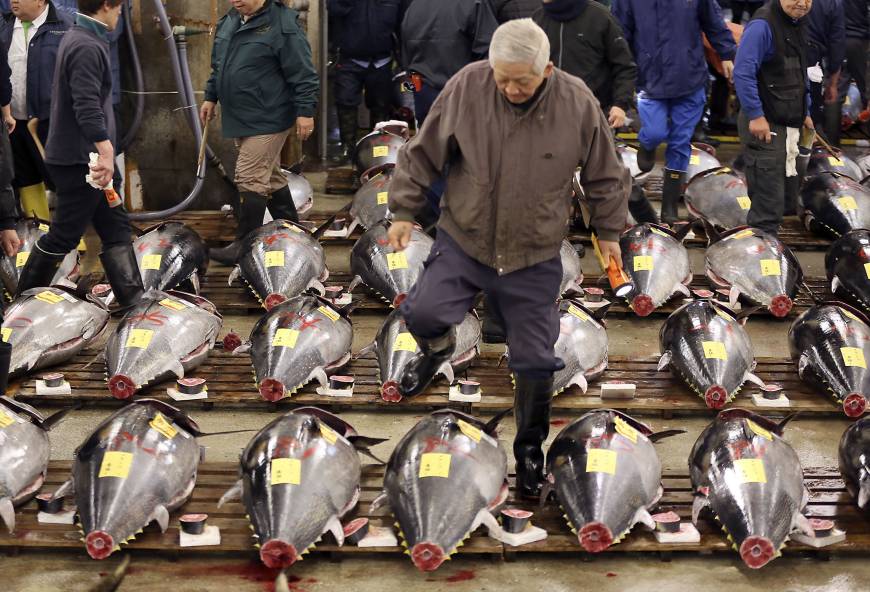
The average weight of bluefin tuna caught is less than half of what it was 25 years ago, the average tuna weighed in at 110 kg to 160 kg in the early 1980s but weighing less than 70 kg in the 1990s and as little as 44 kg today.
The talks took place at the Northern Committee of the Western and Central Pacific Fisheries Commission (WCPFC) annual conference in Kyushu, where host nation Japan proposed invoking a catch limit for two years, but only if the stock of tuna younger than 1 year old remained at a low-level for three straight years. The Japanese proposal guaranteed another 3 yrs of ‘study’ during which fleets would ravage the last of the tuna without pause, at best the proposal is a prescription for another 5 years of the free-for-all catching of the last of the bluefin.
None of the 40 nations attending was ready to stand up and support the Japanese or other propositions on behalf of the tuna and thus all went home after the meeting “could not reach an agreement.”
Outside observers at the meeting including NGO and conservationists proclaimed that urgent action is needed to ensure the world’s largest tuna fishing ground, the Pacific, accounting for almost 60 per cent of the global catch, is protected. But what these groups advocated loudly for is some new form of global government authority to be given command and control authority over the high seas, and the nations that have for centuries exercised the freedom of the high seas.
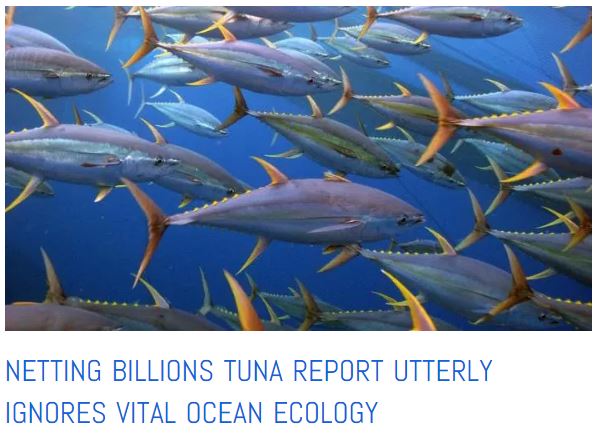
PEW Charitable Trust report on Tuna ignores role of ocean tuna pasture ecology which could readily be sustainably restored at a cost of less than 1/10th of 1% of the value of the $40 billion annual catch – click to read more
The so-called conservationists also refused to speak of measures to become caring stewards of ocean tuna pastures and to restore those pastures to historic health and abundance. There are plenty amongst the NGO’s who are angling to become the mercenary policemen of the high seas provided they are given the resources and legitimacy to operate their private global governance navy’s to run roughshod over what they declare are high seas tuna pirates from every nation. It is no wonder none of the representatives of the 40 nations in attendance were buying into that brand of ‘kool-aid.’
Environmental groups expressed frustration over the stalemate.
Greenpeace calling it “extremely regrettable as the stock of Pacific bluefin tuna is in a state of emergency, Japan, the world’s largest consumer of bluefin tuna, bears the responsibility to strengthen domestic rules (on fishing).
The World Wildlife Fund has recommended the ten major tuna countries introduce a catch limit and adopt a long-term bluefin tuna recovery plan that entails nothing more than hoping that the fish come back once the catch is reduced. This is surely the ‘politically correct’ advice but history shows that such ‘catch’ limitations do nothing to restore diminished ocean fish.
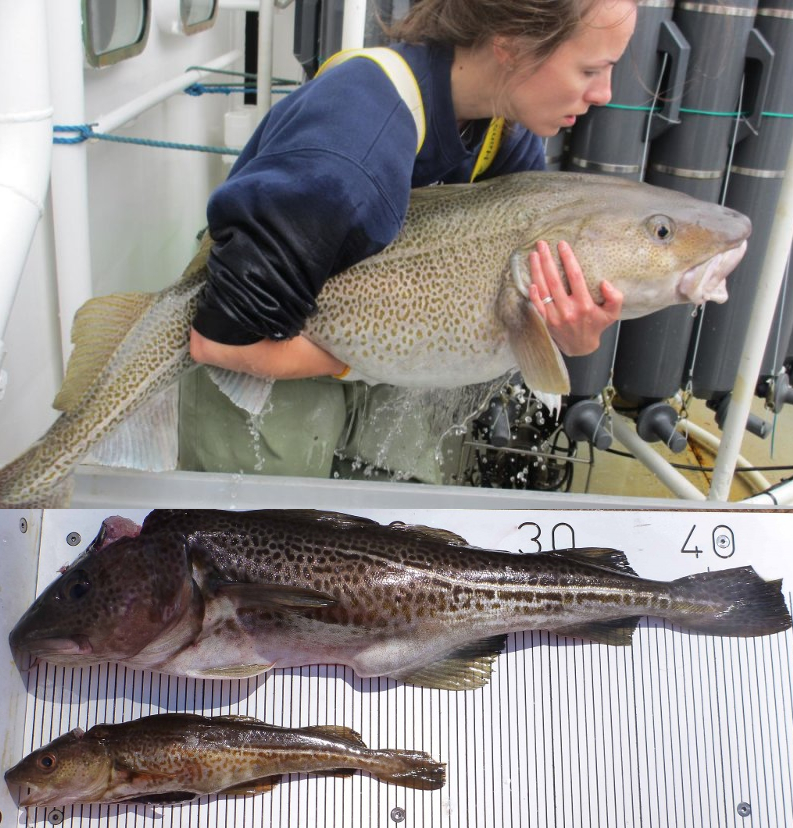
A healthy well nourished Atlantic Cod a meter in length that has grown on one of the remnant ocean cod pastures that is still lush and healthy compare it to the starving cod below where the smallest 20cm cold is a mature fish in “breeding” condition typical of cod barely surviving on desolate and dying ocean pastures.
The Atlantic Cod is a case in point, major catch limits were introduced in 1989 and today more than a quarter of a century later North Atlantic cod have not recovered and those that remain are seen to be starved to such an extent that only small fish remain. Such is the folly of ignoring the basic biological needs of ocean fish and the ocean pastures that sustain them.
The clearly defined dichotomies that separate all of the parties seems to suit them all. The crisis continues which provides for an endless argument making for a perfect tunacrat employment security program, NGO’s have a never-ending supply of ‘the usual suspects’ to wag their disapproving fingers accompanied of course by convenient “donate here button”, and of course the fishers are allowed to pursue the last of the giant Bluefin Tuna with as they become an ever more scarce and valuable trophy. The meeting adjourned with only an agreement that the same issues will be discussed again at the committee’s next annual meeting in South Korea.
Here’s How The Pacific Tuna Can And Must Be Restored
My Prescription To Bring Back The Bluefin Tuna
We now know with great confidence much of the vital biology and ecology of the Giant Bluefin tuna of the Pacific. They are a herd animal just like the great herds of grazing animals on the African Plains or the plains of Asia, like the once countless buffalo of North America that was senselessly hunted nearly to extinction. As with all the great wild herds of the world if we destroy their pastures they will die. Surely we can over-hunt and over-fish which we have inevitably done, and do, but first and foremost to sustain the great herds we must sustain their pastures on land and at sea.
That juvenile Bluefin Tuna pictured at the top of this post given a healthy ocean pasture can grow to weigh over 500 lbs. in just five years time.
That we can over-fish the Bluefin into near extinction is certain given that at this same time their ocean pastures are becoming blue deserts due to the ecological destruction wrought by our high and rising industrial CO2 emissions. The problem with CO2 is that it makes the grass on the Earth grow better and that is the worst news ever for the oceans this is reported widely as global greening.
More grass growing means less dust blowing!
Everyone knows that grass and other plants on land grow in abundance when there is plenty of rain. That’s because it is rain that plants are in most need of, they have the minerals nutrients they need as they grow in the dirt. But ocean plants, the grass of ocean pasture the phyto-plankton, they grow in water and what they must have to survive and thrive is dust. That dust comes to them blown from the land in the wind. But as our high and rising CO2 has produced global greening the ocean pastures are suffering through a terrible drought.
The prescription to return the oceans to historic health and abundance is simple – give back to the ocean pastures the natural dust we have denied it.
For more than 30 years since the late great ocean scientist John Martin proposed this simple ocean remedy hundreds of scientists from more than 50 nations have been engaged in research on how to become proper stewards of our ocean pastures. Humanity learned this on land some 10,000 years ago when we first began to act as caring shepherds of our earthly pastures. It’s not rocket science, just basic common caring agriculture that is almost innate in humanity.
There are plenty of scientific details to know and understand and fortunately we have multi-billion dollar fleets of satellite orbiting our Blue Planet that readily allow us to study and understand the ecology and growing seasons and locations of the ocean pastures that sustain the great herds of Bluefin and other marine life.
We’ve studied and tested idea and you know what? Especially me, as I have performed the largest trial of ocean pasture restoration. IT JUST WORKS!
My 2012 ocean pasture replenishment and restoration work in the NE Pacific returned the ocean to life as seen in the largest catch of salmon in all of history in Alaska the next year. CLICK TO READ MORE
Restoring the Bluefin Tuna pastures of the Pacific Ocean is long overdue. We can, and we must act immediately to bring back those giant fish. Join me.









